Did you know that a mother Harp Seal can identify her pup among thousands of other seals? That is because as soon as the baby is born, the mother will smell the baby to recognize the scent so that she can easily identify it.
Harp seal belongs to the marine mammal groups that usually stay on ice and water for most of their lives. While hanging around on land, it looks very awkward & ham-fisted. Conversely, Harp Seal is highly agile in swimming and prey hunting in the water. But What adaptations do harp seals have? What things affect their behavior? How does human induce their behavior, and what are the conservation strategies?
All these questions made me more passionate about studying the Behavioral facts of Harp Seals, and what I found was quite astounding. And in this article, I have highlighted all my answers regarding my findings. So let’s learn more about Harp seal behaviors, adaptations, and more.
| Behavioral Traits | Key Facts |
|---|---|
| Growing Habits | 01. Physical adaptations in growth & development 02. Life cycle 03. Behavioral differences among species. |
| Feeding Habits | 01. Feeding techniques 02. Food sources 03. and consumptions. |
| Breeding Habits & Migration Patterns | 01. Breeding and mating process, 02. breeding period, 03. selection of the breeding site. 04. Nursing newborns 05. Reason for migration |
| Ecological Adaptations | Important facts about adaptations to the environment |
| Aggression & Territorial Habits | 01. Defeating predators 02. Hunting Food |
| Social Dynamics | Vocalization Skills |
If you are interested in more specific details on harp seal overview, kindly check out the article in my blog.
Why does various Behavior of Harp Seal appear?
Animal behavior is what animals do. From lions and tigers to small fishes in the river, all living creatures have some behavioral traits. And one species of animal behaves differently than the other. The same goes for the Harp seal.
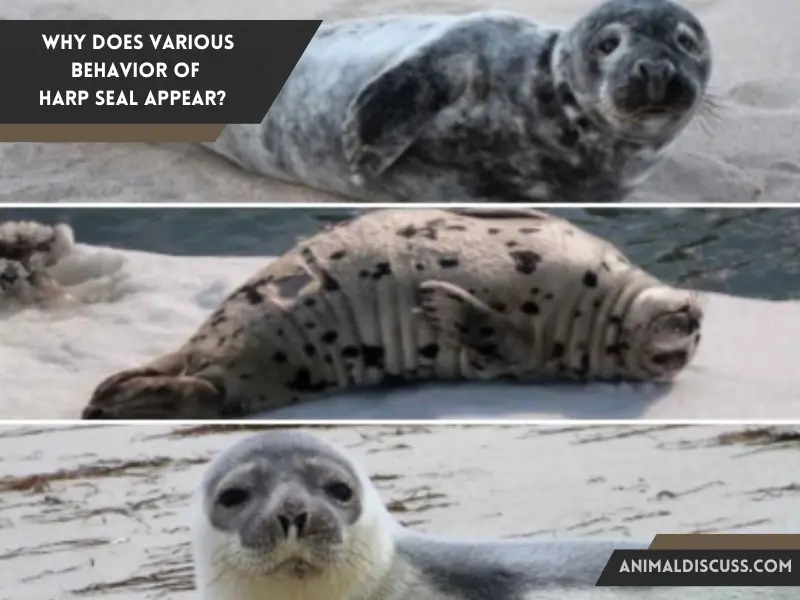
But why do Harp Seal behave the way they do?
Well, it has been found that, like all other animals, Harp seals behave for four reasons:
Foraging Food: Food is necessary for the survival of all living things. In the animal kingdom, food is the primary source of strength, and it directly affects their survival ability. That is why all Harp Seals hunt for food in their own way.
Harp seals use their hearing and visual senses to locate their prey. On the other hand, the Harp seal belongs to the lower food chain, hiding and watching out for predators to ensure their food without getting harmed.
Mating or Reproduction: Without breeding or reproduction, animals will cease to exist. And sometimes, it is essential to reproduce to enlarge the herd or pack for survival. Harp seal’s reproductive activities involve four different stages: choosing the mate, courtship, mating, taking care of the offspring, etc.
The courtship process is different for Harp Seal. At the time of mating, male and female Harp Seals mostly engage with multiple partners.
And after the offspring are born, the Mother Seals take care of their Pups and help them to learn survival tactics as they grow up.
Interact with Similar Species or Groups: Just like humans, this interaction is necessary for any animal group. But what do harp seals do for communication?
Harp seals also interact using three methods: sound, visual, and touch. This behavioral adaptation is required for finding mates, caring for the young ones, altering the group about predators, establishing dominance, etc. And harp seals can only interact with their own kind.
To Survive: Everything that happens in the animal kingdom leads to one primary reason: survival. Harp Seals behave in certain ways, creating dominance, hiding from predators, hunting for food, or enlarging social groups. It is all for survival and safety.
And survival often requires teamwork. That is why many animals are seen to move in packs, like Harp Seal. And while they do not dominate other animals, they certainly fight and show domination among themselves.
Growing Habits: Physical Adaptations
Like everything else, Harp Seals have an incredible growth structure and appearance. And from birth, they undergo various stages of change until they are fully grown. Here are some of the facts regarding Harp Seals’ physical adaptations:
- Like most other seals, Harp Seal also lacks ear flaps. But they do, however, have hearing ability. They have torpedo-shaped body that grows fur over time. They have front flippers with strong claws and long back flippers with smaller and narrower claws. And when a Harp Seal moves, it looks more like a caterpillar moving but only a few feet bigger.
- Harp Seal has eight pairs of teeth on both the upper and lower jaws. These seals grow about 5 to 6 feet over time. And as they grow, male harp seals begin getting dotted harp-like marks on their back, which take a full-size form when they are fully adult.
- However, females don’t have such marks. And the male Harp Seals grow more prominent than the females, and they all can weigh as much as 250 to 300 pounds.
- Harp Seal pups often adopt a yellow-white coat after birth. But within 1-3 days, it turns to white & remains the same till its molting time. The newborns are well-known for their snowy white coating.
- Young Seals adapt fatty blubber under thick skin, which keeps them warm in arctic water. This blubber fetches forward to swim & dive extremely well.
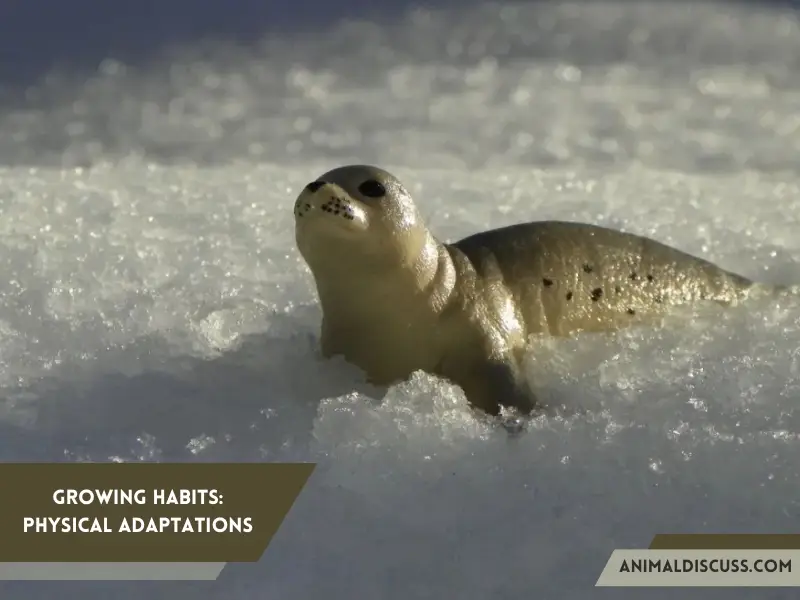
Facts of Harp Seal Growth and Physical Appearance
- Generally, a Harp seal pup weighs about 11 kilograms. But because of the high fat in a mother seal’s milk, the pups gain around 2kg of weight each day.
- They have flat but wide heads.
- They have eyes larger than their body proportion, which allows them to see better underwater.
- Harp Seal has a strong sense of smell & can respond to low-frequency vibration while in movement.
- Harp Seal performs as a heat exchanger through their flippers which warm or cool as required. They can redirect blood flow to reduce heat loss outside the body.
- The harp shape on its back can take several years to form.
- Harp Seals also have white fur but become light gray over time. The white fur lasts only a few weeks after the pup is born.
- The fur absorbs sunlight and keeps the pup warm.
- Harp Seal’s average lifespan is around 30 years.
Comparison of Growth Habits:
There are at least 33 different seal species living in nature. While there are similarities in many of their behavioral traits, there are also certain differences. Let’s have a look at various species’ growth and other habitual comparisons.
| Species Name | Found In | Adult Size/Long | Weight | Population |
|---|---|---|---|---|
| Harp Seal | North Atlantic, Arctic Ocean, Greenland, etc. | 5-6 feet | 250-300 pounds | Around 7.6 million |
| Harbor Seal | Europe, Asia, and North America | 6 feet | Up to 285 pounds | Around 350,000 to 500,000 |
| Bearded Seal | Sub-Arctic and the Arctic Ocean | 7-8 feet | 575-800 pounds | More than 500,000 |
| Gray Seal | North Atlantic, Norway, Iceland, and Russia | 7.5-10 feet | 550-880 pounds | Around 450,000 |
| Hawaiian Monk Seal | Northwestern Hawaiian Islands | 7-7.5 feet | 375-450 pounds | 1570 |
| Northern Elephant Seal | North Pacific Ocean | 13 feet | Around 4,000 pounds | 160,000 |
| Hooded Seal | Western and Central North Atlantic | 8.5 feet | 423-776 pounds | 650,000 |
| Ringed Seal | Baltic Ocean, Hudson Bay | 4-4.5 feet | 110-150 pounds | Over 2 million |
| Ross Seal | Antarctica | 7.6 feet | 330-470 pounds | About 220,000 |
Feeding Habits
Like other seals, Harp Seal source their food from the ocean. While the young seals are breastfed by their mothers for a certain period, they move to solid food pretty faster.
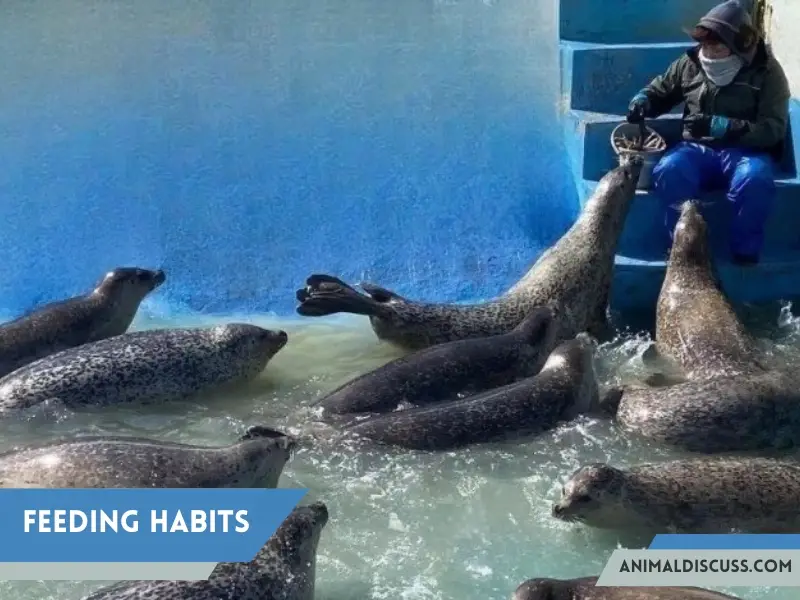
Here, let’s have more exciting facts about the harp seal’s feeding habits.
Adult Harp Seal Feeding Habit
You should know that adult Harp Seals are carnivorous, and the most significant source of their food is small fish. And they also prefer eating squid, crustaceans, etc. But what makes their feeding habit more fascinating is how they consume their food.
Harp Seal do not chew their food. Instead, they would tear the bigger pieces into small portions and crush them with their back molars. Or, they would eat it as a whole. And they would consume 5% of their body weight to ensure enough strength.
And as they live on ice or around sea areas, food becomes more easily accessible. They can dive into the water and look for food wherever necessary. But what gives Harp Seal the biggest advantage in foraging is its swimming ability and the capacity to dive deeper.
Harp Seals are excellent swimmers. And as they can slow down their heart rate, they can stay underwater for 15-20 minutes without requiring to get out of it. That is why they can hunt for a long time.
Young Harp Seal Feeding Habit
Now, what about young Harp Seals? Are they also born carnivorous?
Actually, When the pups are born, the weaning process starts. Though Harp Seals are carnivorous, they are not born carnivores. Because they are breastfed and drink high-fat milk (50% fat), the pubs gain about 2-5kg of weight every day. It also happens due to heavy food consumption.
Weaning can happen any time during the first one or two weeks after the pups are born. When the newborn reached 36 kg (79 lb), the mother would abandon the pups alone. Since the pups do not learn to swim or hunt for food for around 40-45 days, they would lose a big portion of the weight they gained from being breastfed. Some even get killed by predators during this time.
Once they begin to hunt on their own, they would go choose crabs as their prey at first. If the prey is small, they will eat it underwater. If not, they will bring the prey to shore and eat them. And as they grow up and get bigger, their diet changes over time, and they move to the upper section of their eating habit.
Breeding (Mating) Habits & Migration Patterns
The months from Mid-February to April are the ideal breeding season for Harp Seals. You might face a question in mind while reading, Do Harp seal migrate?
Yes!! Harp Seal migrate in larger groups during their mating and breeding season, which happens annually and covers hundreds and thousands of miles. Though courtship is started on the ice, their mating sites are in the water.
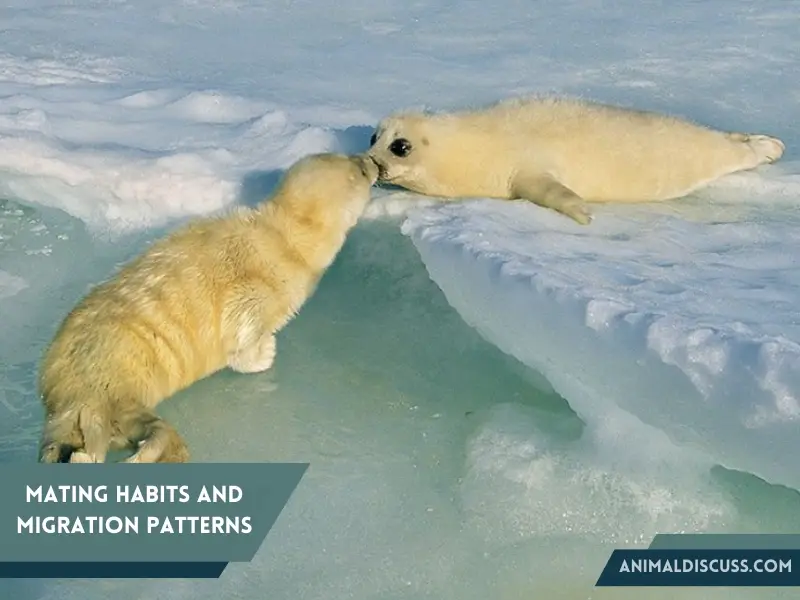
A female Harp Seal matures at 5 to 7 years of age. On the other hand, males mature around the age of 7 to 8. And because Harp Seals are mostly polygynous, the males mate with multiple females during the breeding season.
To woo a female, the male Harp Seal would make various sounds, gestures, blows bubbles, etc. They would even chase after the females to impress them. And if there are males after a single female Harp Seal, the males would fight by biting and flippering. The dominating male, who wins the fight, mates with the female.
As for their breeding ground, they would choose the White Sea, the Greenland Sea, or Northfoundland. But when Does Harp Seal migrate?
Let’s see! Harp seals spend their summer days mostly in Greenland and Canadian Arctic. Then in the fall (November-December), a large number of harp seals would migrate to Northern Newfoundland. But some would also travel to Southern Labrador or the south of the Gulf Sea. Harp Seal would travel annually around 2000-3100 miles round trip.
Harp Seal Breeding Facts:
- They give birth to their pups on the ice.
- The pregnancy lasts around 11.5 months before the pups are born on the ice.
- A newborn pup weighs about 25 pounds and is at least 3 feet tall
- It takes about 4-6 weeks for the pup to be fully independent.
- After 12-14 days, when the mother leaves her pup, it will stay near the place where its mother has left. And they will lose about 50% of their weight during that time.
Ecological Adaptation
One of the wonderful things about Harp Seal is that they can adapt to ecological changes. Harp seals eat small fishes, squids, crustaceans, etc.
On the other hand, harp seals are food sources for marine predators, such as sharks and whales. Thus they are contributing to the marine food chain. Their movement also helps cycle water nutrients and transfers them to the seashores, contributing to the marine ecosystem.
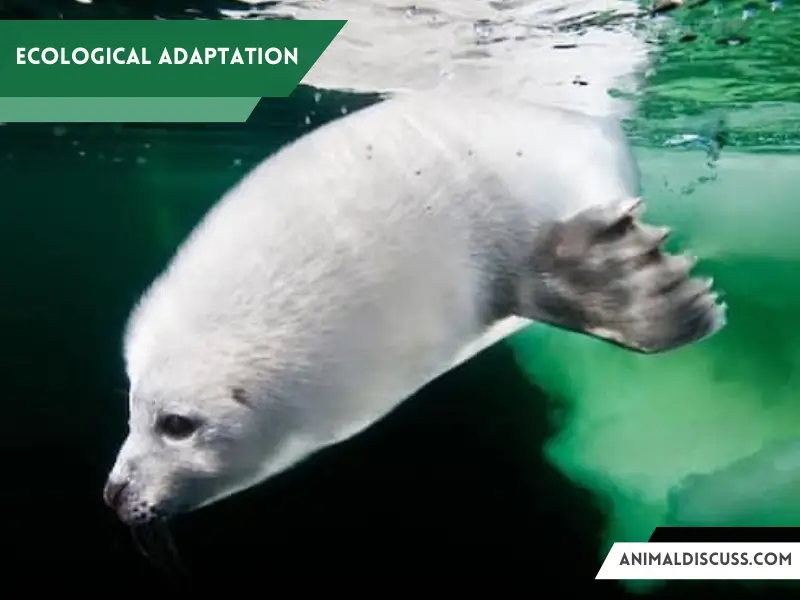
But when it comes to ecological adaptations, how do you think the harp seals do that?
Diving: Since Harp Seals spend a great deal of time in the water, they adapt to control their heart rate by 90% when underwater. They are sleek swimmers and would dive over 500 meters down the sea with an average diving rate of 8.3 dives per hour.
And their duration of diving is from 02-20 minutes over. They can do it to conserve oxygen levels so that they can remain submerged without returning to the surface.
During spring & summer, most of the Harp Seal dive less than 50 meters while foraging alone in the ice.
Regulating Body Temperature: Like other adaptation skills, Harp Seal can regulate their body temperature, which helps them during ecological change. But How does Harp Seal adapt to the cold? Under their skin, they have a thick layer of bubblers, which turns out to be helpful when it comes to holding their body temperature. Moreover, their fat layers help them store energy, allowing them to adapt to cold and survive in their environment.
Skin Molting: Harp Seals go through the molting of skin every spring. As they get rid of their old skin and fur, they stay on the land and wait for their body temperature to be suited for the water temperature. But this is also a risky time as hunters often hunt Harp Seals because of their valuable insulating layer, which offers thermoregulation.
Offspring Survival: The survival rate of Harp Seal offspring is very low for the first several months of birth. During this time, the pup mortality rate can grow between 20%-30%. This can happen due to several factors, such as being crushed under ice or drowned, dying during the time their mother abandons their offspring on its own.
But how do young Harp Seals adapt to their environment? The pups rely on solar heating because of their premature blubber layers, which help them adapt to changes in environmental temperature. They also depend on some behavioral responses, such as seeking warmth in the water.
Aggression and Territorial Habits
Aggression towards others or territorial behavior is just another behavioral tactic of Harp Seal. They are not exactly violent. However, they can turn against each other or against different species for various reasons.
Predator: Harp Seal’s ability to live on land and water helps them trick and survive predators, which can be both humans and animals, such as polar bears, foxes, wolves, killer sharks, whales, walruses, etc.
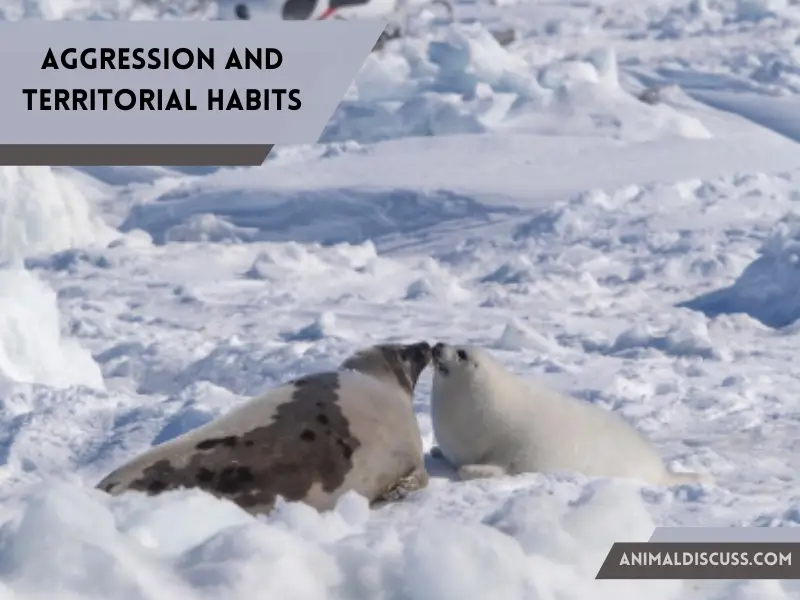
How do harp seals protect themselves? If they feel threatened or grabbed on land by a predator, they usually thrash and try to bite and swim away to defend themselves. But when the predator is water-bound, the seals use their moving tactics to outmaneuver the predator and get on the land.
Prey Dynamics: Since Harp seals gain about 5% of their body weight each day, that would require a good amount of food. The good thing is that they can stay 15-20 minutes underwater, which gives them enough time to hunt. The fish they catch, usually small, are eaten easily while underwater. But for larger prey, the seal needs to come out of the water to eat it.
Social Behavior
Harp seals are vocal when it comes to communicating with each other, during mating, warning others, and so on. The sound that pups make to call their mothers or when hungry is called bawling. They would often mumble when playing.
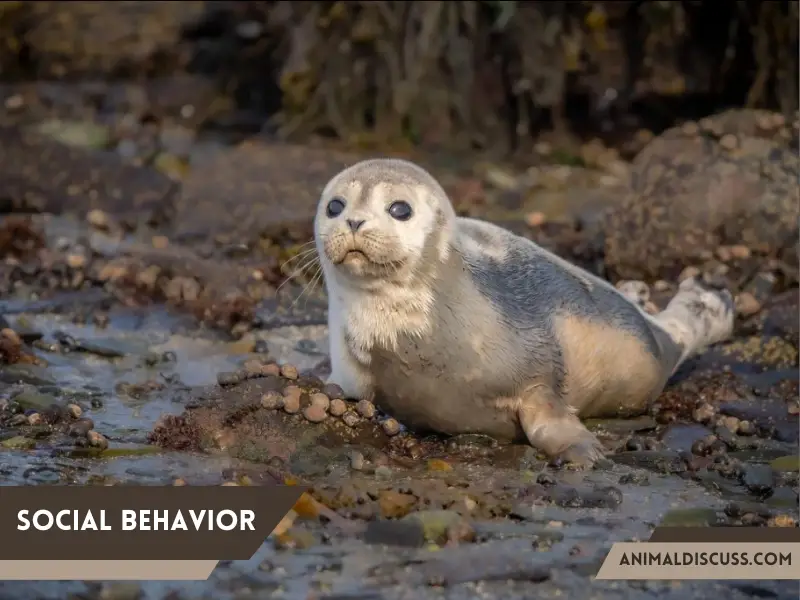
On the other hand, the adult harp seals would growl when warning others regarding potential threats. And the most interesting fact about them is that they would make more than 19 different identified sounds while wooing a partner, courtship, and mating. Older harp seals would make agonizing warbling sounds.
Do Harp Seals communicate with humans? Harp Seals are pleasant marine creations that appear interactive and sociable with humans. But maintain your distance while in the wild because they may be distressed by human attention in their natural habitats and can feel endangered.
Facts Influence On Behavioral Traits
Animals live, breed, and adapt according to their environment. However, with the rapid change in the environment, a profound change can be seen in their behavior. And it is also making animals change the way they adapt and survive certain changes in the environment.
So what are the vital facts that influence harp seal behaviors or behavioral traits? Here are some of the facts that you need to know.
Physical Factor
- The high-fat milk from their mother’s breast milk makes harp seal pups gain much weight.
- The change in reproductive rate influences the harp seal’s body size, weight, and growth.
- Availability of food also influences the harp seal’s growth and population size.
- Sometimes, as the pack ice expands, it would carry pups to another location, which is yet to survive the weaning. Thus it challenges the harp seal’s survival behavior.
- Another factor responsible for harp seal population growth is the contribution of seasonal ice cover and cold Labrador current.
Environmental Factor
- Global Warming is intensely responsible to affects the Harp Seals population as they breed on ice & snow.
- Due to warm weather & natural disasters, the Harp seal loses their prey which affects the availability of their food adversely.
- For changing Climate rapidly and its impact on the arctic ocean impose deterioration of Harp Seal ice habitats.
- Marine plastic debris also has a massive influence on reducing fish stock.
- As environmental and ecological changes force other animals to change diets, many of them, such as polar bears, are moving to harp and hooded seals as prey.
Human-Induced Factor
Well, though humans are not always directly present to influence changes in nature, their overall actions are causing a massive disturbance in nature. And here is how it is affecting the survival of many animals and changing their behaviors, including the Harp Seal.
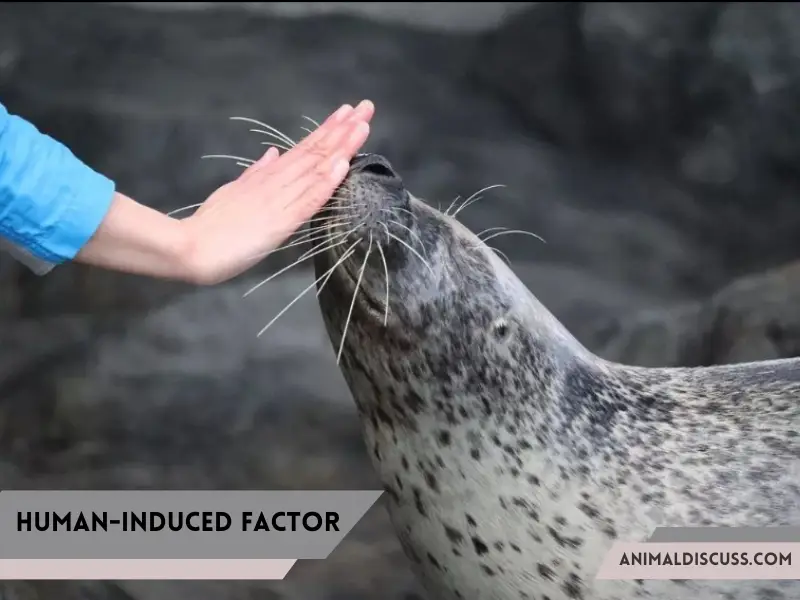
Hunters: The animals in the wild are not the only thing that hunts Harp Seal or any other animal of the lower food chain. Hunters hunt them for various commercial purposes, as they are valuable for oil, meat & fur skin.
Boats/Vessels: Since Harp Seal spend a big part of their life in water, it is not uncommon for them to be stroked by passing boats or other water vessels. As a result, they are often severely injured, and many of them die from such incidents.
Entanglement: Sometimes, unintentionally, hunters of other animals endangered Harp Seals. Laid traps, wire, left-out garbage, finishing nets, etc., are among the most dangerous that often kill Harp Seals. The seals, entangled in all these, suffer the most as not many of them can manage to get out of the trap and die eventually.
Oil Spills: Illegal discharge of oil into the sea has been known as one of the most threatening human-induced causes that kill many animals and sea creatures, such as Harp Seals. Other than polluting the water, it is also responsible for lowering the oxygen level in the water and suffocating the animals to death.
Chemical Contamination: Sometimes, vessels containing them suffer damage, and accidents cause severe contamination. This contamination causes loss of food for the wildlife living around the shore, reduces reproduction, and causes disturbance in the food chain.
Other Factor:
- The growing number of harp seals is attracting hunters to hunt them.
- Overfishing may cause scarcity of food in the marine ecosystem.
- But because of lower catches and interpretation of various organizations, the number of harp seal losses has reduced.
Conservation of Their Behavior
Is Harp Seal endangered? Though many harp seals are killed annually, they are said to be not endangered. In fact, over the last few decades, the estimated number of Harp Seal has increased.
To conserve Harp seal natural behavior, some initiative need to take under consideration immediately-
- Restrict hunters from killing Harp Seal for commercial uses.
- Reduce Boats & vessels floating in the area of Harp Seal’s Habitats.
- Prevent Ocean pollution from human activities.
- Should abrupt Oil spill in the ocean.
- Avoid overfishing in the ocean to restore the availability of food resources in the marine ecosystem.
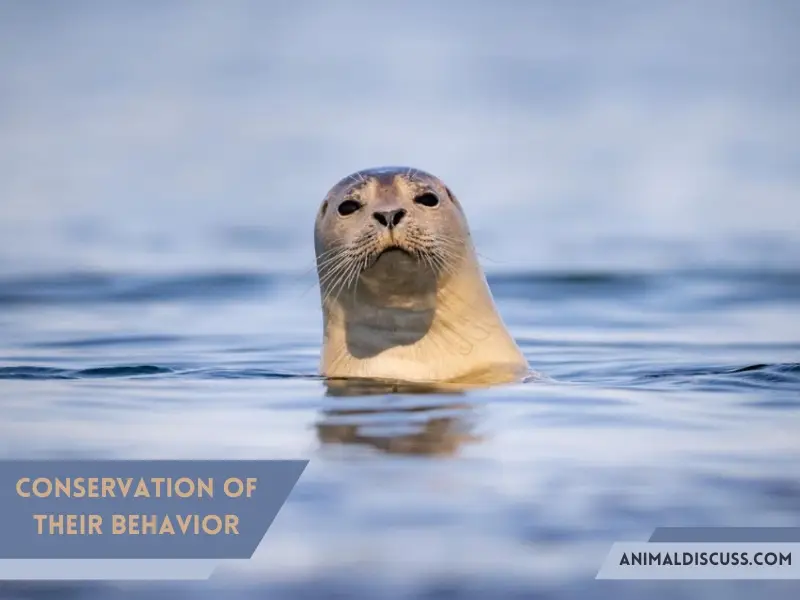
You will be delighted to know that; a big portion of harp seal conservation is done by various organizations. And here is more on the steps taken to conserve harp seals-
- National Oceanic and Atmospheric Administration (NOAA) is an organization that works to conserve harp seals and has taken various actions.
- NOAA targets reducing oil spills and vessel strikes, educating the public regarding the importance of Harp Seal to reduce hunting, etc.
- Another organization, IFAW (International Fund for Animal Welfare), aims to end commercial seal hunting in Canada.
- IFAW documented seal hunting and ensured the media, experts, and politicians knew of the cruelty. Thanks to them, in 2009, the EU banned all kinds of seal products.
- And Marine Mammal Rescue & Research is an organization that helps treat seals by sedating them with darts at first.
- The Canadian Government issued an astronomical quota on killing the pups of harp seals.
Conclusion
Despite having a population of around 9 million, Harp Seal is still among the endangered animals. And being natural predators themselves, Harp Seals have shown noticeable adaptation and survival skills over the decades. But now that the world climate is changing drastically, we can expect to see more changes in this cold-weather animal. Will they survive the new and unseen changes of nature? That is still to be found!
And as part of their survival, harp seals adapt to a particular eating habit. And if you want to know more about harp seal’s food & diet or their habitats, I suggest you check out Harp Seal Food & Diets, Harp Seal habitats.
Article References:
- https://www.fisheries.noaa.gov/species/harp-seal
- https://kids.nationalgeographic.com/animals/mammals/facts/harp-seal
- https://www.britannica.com/summary/harp-seal
- https://www.ifaw.org/animals/seals
- https://www.harpseals.org/about_seals/seal_conservation.php

